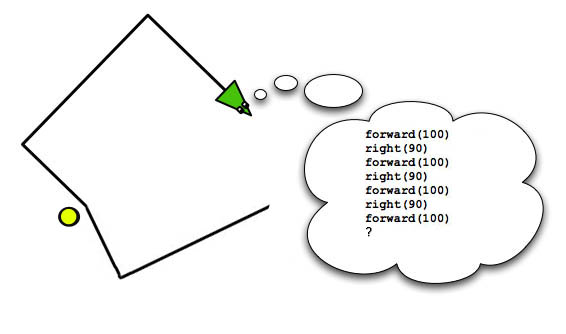Question: if you lived in flatland (a 2-d world), how could you tell if the land was curved in the third dimension?
Answer: geometry!
It turns out many of the mathematical rules we learned at school ‘fall apart’ if the working surface is curved. For example, can you draw a square on the surface of a sphere? No!
So can we use this insight to tell if our 3-d world is curved in a mysterious fourth dimension? Yes!
If we set off from earth, went in straight line for, say 1 light-year, then turned 90º, went 1 light-year, turned 90º again, and then did this yet again, you should have traced a perfect square, and be back exactly where you started. If you aren’t, something is amiss!
 Now it turns out that it we do this, we will indeed discover an error; but why? And how do we know this?
Now it turns out that it we do this, we will indeed discover an error; but why? And how do we know this?
===================
Newton told us that a massive object in motion will continue to travel in a straight line, unless acted upon by external forces. Some people think that Einstein overturned this insight, but he didn’t; indeed he extended it: he said that the force of gravity is not actually a force, and thus objects falling under gravity are actually going in straight lines! Indeed this makes sense, as anyone ‘falling’ does indeed not sense any acceleration, but rather feels ‘weightless’. Thus they are not actually accelerating, they are going straight – in curved space.
Now anyone who has thrown a ball can see this is absurd on the face of it, but Einstein was serious, and he is right, from a certain perspective. The ball is not going in a straight line through ‘regular’ space, but is going on a straight path in a 4-d construct called ‘space-time’. Likewise, he would argue that the planets are tracing straight lines around the sun; and indeed the ‘parabola’ of a baseball is actually not a parabola, but a very small part of the enormous ellipse that would be traced in the baseball could fall though the earth and go into ‘orbit’ §.
Anyway, Einstein’s model says that light travels in straight lines, but we have seen that light bends when it passes near to the sun (this can most easily be tested during an eclipse) – so… if one of the sides of your ‘perfect square’ were to pass near the sun, it would also be bent and if you followed the above rule to draw the square, you would not end up where you started.
===================
Physicists have grown used to Einstein’s model, and better tests for the flatness of space have been developed. For example, if you drew a circle on the surface of a sphere, the area would not equal Πr2, but would be less. Likewise, in 3-D space, we could plot a sphere and then measure the volume and if it did not equal 4/3Πr3, we would know something was amiss.
So physicists have looked at how light bends, and how the planets move, and found out, amazingly (but predicted by Einstein) that the error in this spherical volume calculation is directly proportional to the mass of matter within the sphere – proving that the warpage in space is proportional to (and thus caused by) ‘mass’. Thus mass warps space.
===================
But is space really warped in some ‘extra’ dimension?
Well, this is a good question. Maybe it is some extra ‘spacial type’ dimension, but you could also look at time as a fourth dimension, and argue that this space is not ‘curved’ at all, but rather that space and time simply vary in density in different locations. I personally like this way of looking at it, it eliminates the need for some vague ‘extra dimension’, and therefore swiftly removes the possibility that space could be ‘closed’ or fold back on itself in this extra spacial dimension. Occam’s razor thus prefers the ‘density’ model!
Footnotes:
§. In Wikipedia, they state that balls bounce in perfect parabolas, but note they also mention a ‘uniform’ gravitation field, and it is well to remember that the earth gravitational field is not uniform, but radial. Thus I stand by my assertion that missiles follow elliptical paths just like planets and comets. Of course, an ellipse is a close relative of both the parabola and the hyperbola, so this is not really that dramatic.
